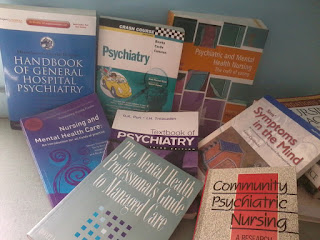Mental problems in Zimbabwe
“WHEN the video of a smiling Caroline Rusike was circulated around social media networks showing her walking stark naked on the streets of Harare while being jeered and mocked by a large crowd, no one attempted to come to the young woman’s rescue or at least cover her up and, instead, they whipped out their mobile phones to take pictures of the woman. Yet Rusike aged 33 of Harare, reportedly has mental health problems and was a patient at a mental health institution in Harare. She represents just one of many people who suffer from mental health problems in the country, but who ordinary Zimbabweans do not understand or have sympathy for as mental illness is often misunderstood and mystified, with patients suffering a lot of stigma yet it can affect just about anyone. There is a general perception the mentally-ill are violent and most employers shut the door on those who have suffered mental illnesses for fear they may recur.
Mental patients are often ridiculed and abused by society, as in Rusike’s case, while in some instances they are viewed as social outcasts, hence their high number on the streets where they lead desperate lives. While there have also been reports of mental health challenged people being physically abused, with some being chained or kept in isolation in inhuman conditions while others have been emotionally and sexually abused.
Last year, the country recorded an unprecedented rise in mental health incidences, with more people being diagnosed with mental illness.
In Zimbabwe, according to Madhombiro, there are very low number of psychiatrists in the country as well as staffing levels, especially at government psychiatric institutions, Ingutsheni, Parirenyatwa and Ngomahuru in Masvingo. It is for this reason that mental patients like Rusike are not likely to get much help.
An estimated 1, 3 million Zimbabweans have some form of mental illness, according to government data.
The health minister explained that sometimes we do not understand why some people go into some tempers unexpectedly, but the harsh economic situation causes a lot of stress, while post traumatic disorders, due to lack of counseling for soldiers post-war cause a lot of problems. Another major problem is drug abuse; we need to deal with the issue of illicit drugs.”
Ministry statistics show that there are 91 390 mentally-ill patients in Zimbabwe with 7 763 new mentally ill patients were seen in government hospitals from January to October 2014. Its a phenomenon that is growing increasing in Africa and Zimbabwe has not been spared, according to the minister.
Notwithstanding the stigma and marginalization of such patients in Zimbabwe’s communities, support and scope of services remain limited owing to serious funding challenges that have left institutions operating with skeletal staff. The country has two dedicated mental hospitals, Ingutsheni in Bulawayo and Ngomahuru in Masvingo, while other major referrals have units for such patients. all these are very understaffed with Ingutsheni having one instead of eight psychiatrists and Ngomahuru having none, while Parirenyatwa and Harare Hospital but they have around 10 instead of 20.
WORLD WIDE
According to the World Heath
Organisation, Worldwide, nearly 1 in 10 people have a mental health disorder,
but only 1% of the global health workforce is working in mental health. This
means, for example, that nearly half of the world’s population lives in a
country where there is less than one psychiatrist per 100 000 people.Huge inequalities in access to
mental health services exist depending on where people live.
Maternal mental health
Worldwide about 10% of pregnant women and 13% of women who have just given birth experience a mental disorder, primarily depression. In developing countries this is even higher, i.e. 15.6% during pregnancy and 19.8% after child birth. In severe cases mothers’ suffering might be so severe that they may even commit suicide. In addition, the affected mothers cannot function properly. As a result, the children’s growth and development may be negatively affected as well. Maternal mental disorders are treatable. Effective interventions can be delivered even by well-trained non-specialist health providers.Child and adolescent mental health
Worldwide 10-20% of children and adolescents experience mental disorders. Neuropsychiatric conditions are the leading cause of disability in young people in all regions. If untreated, these conditions severely influence children’s development, their educational attainments and their potential ....Moreover, the extension of life expectancy and the ageing of the general populations in both developed and developing countries are likely to increase the prevalence of many chronic and progressive physical and mental conditions including neurological disorders.
http://www.who.int/mental_health/suicide-prevention/en/
Suicide
Over 800 000 people die by suicide every year – that’s one
person every 40 seconds. Yet these deaths are preventable. FOR MORE VISIT ...
http://www.who.int/mental_health/neurology/en/
http://www.who.int/mental_health/neurology/en/
SOME BOOKS IN OUR LIBRARY COLLECTION ON MENTAL HEALTH
1.
Nursing
and mental health care: an introduction for all fields of practice by Steven
Trenoweth …[et al].
2.
Sims’
symptoms in the mind: an introduction to descriptive psychopathology by Femi
Oyebode
3.
Psychiatry
by Julius Brourke, and Matthew Castle
4.
Textbook
of psychiatry by Basant K Puri and Ian H Treasaden
5.
Community
psychiatric nursing: a research perspective edited by Charles Brooker
6.
The
mental health professionals guide to managed care edited by Rodney L lowman and
Robert J Resnick
7.
Massachusetts
general hospital handbook of general hospital psychiatry by Theodore a Stern
…[et al].
8.
Psychiatric
and mental health nursing: the craft of caring editd by Phil Barker.

Comments
Post a Comment